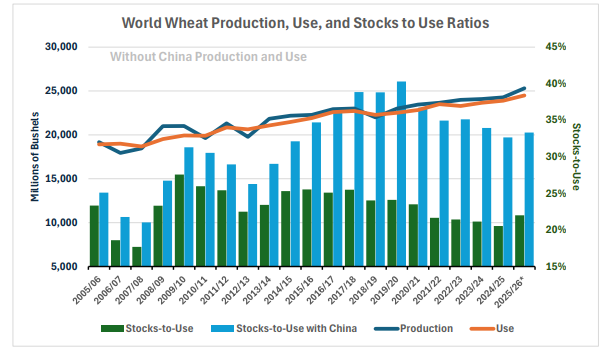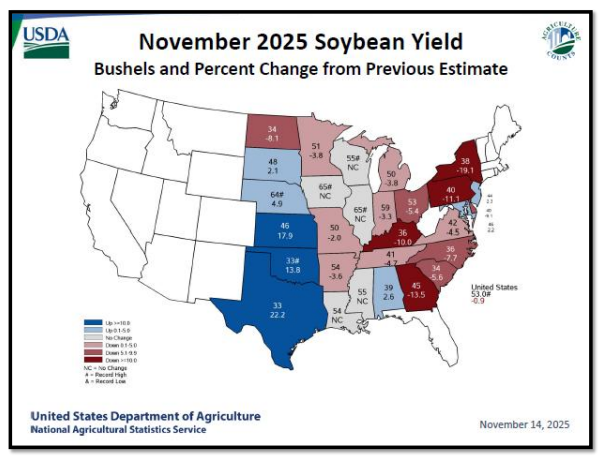
Market News:
On Friday November 14, USDA released the Crop Production and WASDE reports. These reports capped an uneventful week in the futures markets as participants positioned themselves for USDA data. While the reports were
highly anticipated, the data left a bit to be desired from a producer perspective. This newsletter reviews the major takeaways and implications from those reports. On a positive note, the markets recovered on Monday from the severe
reaction after the reports.
Wheat Market Outlook:
KC hard red winter wheat prices fell last Friday to close at $5.15 in the December futures contract. Wheat prices across all major contracts dropped on a bearish supply outlook both domestically and internationally. KC December Hard Red Winter futures contract closed Monday at $5.29 per bushel after seeing a high of $5.39 early in November. On the domestic balance sheet, the WASDE report increased production based on the Small Grains Summary report from September but left exports at nine hundred million bushels. Ending stocks increased the full fifty-eight million bushels to 1.985 billion bushels in contrast to market expectations. There is reason for concern because it seems likely USDA saw export sales figures that have yet to be released to the public when making this forecast. Export inspections on Monday totaled 454 million bushels through November 13 Over the last month weekly exports averaged 10.6 million bushels per
week, down from over twenty-three million bushels a week from the start of September through mid-October. The numerous trade deals that have taken place mentioned wheat buying, particularly in Asia. While exports to Indonesia, Vietnam, and Thailand appeared in this week’s export inspections, one must wonder about the potential buying given USDA’s forecast. Strong competition is taking its toll as shown in the international section of the WASDE.
The WASDE report raised 2025/26 world production 466 million bushels (12.7 MMT) from the September forecast with many major exporters seeing larger production. While an expectation of higher world production was in place, the magnitude and subsequent change in world ending stocks sent a bearish signal for U.S. wheat exports. Ending stocks outside of China are forecast to increase 271 million bushels from the last report. The world stocks to use ration excluding China for 2025/26 is forecast at 22 percent, up 1.5 percent from the 2024/25 marketing year estimate.

The wheat market price recovery on Monday appears to have shrugged off the negativity around the
Friday report and followed soybeans higher. Nonetheless, a fundamentally strong supply situation
around the globe remains in place for the rest of the marketing year. Expect more volatility in the wheat
market moving forward.
Soybean Market Outlook:
USDA placed soybean yield at 53 bushels per acre in the November crop report, down 0.5 bushels per
acre from September. The change in yield equated to forty-eight million fewer bushels on the balance
sheet in the WASDE report. The change was offset by exports being lowered to 1.635 billion bushels,
down fifty million bushels on intense competition out of South America and USDA’s belief that the
trade deal with China will make U.S. soybeans less competitive in non-China markets. Brazilian
soybean export prices falling below U.S. prices supports this idea. Ending stocks were down slightly to
290 million bushels.

Global soybean production for 2025/26 was forecast 151 million bushels lower at 15.5 billion bushels.
Ending stocks moved slightly lower on a smaller expected crush in India, due to a lower crop, and Argentina due to lower supplies because of stronger exports to China. Global vegetable oils are forecast to have slightly lower production and usage than presented in September but are still higher than last marketing year. While negative, the large price drop seen on Friday was more linked to a lack of soybean exports and the subsequent reduction than any unexpected surprises in the report globally.
Monday, November 17, saw a massive price rally to recoup all the losses seen on Friday. The nearby January soybean contract fell over twenty cents on Friday but closed over 30 cents higher on Monday at $11.57 per bushel. There are two market movers to credit for this rally. One was a massive NOPA.
soybean crush number reported for October. At 227.65 million bushels, the oilseed processor report was a record for any month not just October. The enormous number confirms expansion and crush capacity to meet soybean oil needs and global meal demand. The other was continued reports of China buying soybeans to meet trade deal promises. Multiple cargoes were reported as purchased by China on Monday. Cash prices in Oklahoma yesterday surged to $10.81 cents. For marketing purposes, these types of rallies should not be ignored.
Corn/Sorghum Market Outlook:
USDA’s corn yield forecast of 186 million bushels can easily be classified as the most disappointing number from the data dump on Friday. Most analysts were expecting a yield closer to 184 and the 0.7 bushel per acre yield drop was extremely bearish. Record corn yields reported through the heart of the Corn Belt have raised skepticism as to what the actual final yield will be when reported in January. While it is easy to dismiss the report, one should be careful when considering marketing as the market appears to be pricing in a yield in the 182-184 range.

The balance sheet changes for old crop discussed in last week’s newsletter happened and there were few surprises for the 2024/25 marketing year. USDA raised 2025/26 demand by one hundred million bushels on stronger exports. Export inspections came in at 624 million bushels as of November 13, over 260 million bushels above last year. Strong inspections and flash sales point to robust outstanding sales as confirmation of USDA’s large export total.
Total usage is set at a whopping 16.155 billion bushels. All the caveats mentioned last week on feed and residual usage and corn use for ethanol are still in play. Ending stocks came in at 2.15 billion bushels, the largest since 2018/19 marketing year. If production does not come down, the ability for demand in USDA’s current balance sheets to increase is severely limited.
December corn futures fell eleven cents on Friday to $4.30 per bushel and corn put in the weakest showing on Monday in closing at $4.35 despite large rallies in other crops on Monday. Corn in Oklahoma was priced on average around $4.22 per bushel on Monday and has been following the December futures contract.
Sorghum production was forecast at 428 million bushels, up twenty-six million from September. A seventy-five bushel per acre yield drove production higher. The 4.6 bushel per acre yield jump was driven by a ninety bushel per acre crop in Kansas. Oklahoma came in at 60 bushels per acre. USDA forecast ending stocks at forty-three million bushels, down one million from September. Food, seed, and industrial use was upped to one hundred million bushels on ethanol grind. Exports are still being forecast at 225 million bushels as we all wait on China to buy sorghum and for the sales to show up in the data. Oklahoma sorghum prices remain low as basis remains weak on large supply and muted export demand. Export inspections thus far in the marketing year are at 13.6 million bushels, down 55 percent from last marketing year.
Oklahoma cash sorghum prices select location


















